Unfold the magic behind DRM with Thu Do Multimedia in the article below!
What is DRM?
Involves the application of technology to regulate and oversee access to copyrighted materials. An alternative interpretation of DRM is the transfer of control over digital content from the individual possessing it to a computer program. The primary objective of DRM is to safeguard the rights of copyright holders and thwart unauthorized distribution and modification of content.
The significance of DRM has grown with the proliferation of digital content via peer-to-peer file exchanges, torrent platforms, and online piracy. It serves as a crucial tool for entertainment and media companies, aiding them in addressing the cybersecurity challenges inherent in safeguarding customer data, ensuring compliance, optimizing operational efficiency, and preventing disruptions.
DRM empowers authors, musicians, filmmakers, and other content creators by providing them with the means to specify and manage permissible actions regarding their content. It furnishes a mechanism to shield copyrighted material, preserving the creative and financial investments made in their work, and making it infeasible for their media to be illicitly shared or pilfered.
For instance, it enables the prevention of user access to specific assets, thereby averting potential legal complications arising from unauthorized usage. This aspect is pivotal in upholding copyright and protecting intellectual property.
What is the functioning mechanism of DRM
Copyright laws encompass the unauthorized distribution, sharing, and alteration of digital content, but monitoring the internet for illegal activities poses a formidable challenge. DRM tackles this issue by implementing barriers to thwart the theft of digital content.
DRM commonly employs codes to prevent content copying or restrict the number of devices that can access a product. Content creators may also utilize applications to control user actions with their material or encrypt digital media, requiring a decryption key for access.

What is the functioning mechanism of DRM
This empowers content creators and copyright holders to:
- Restrict users from editing, saving, sharing, forwarding, printing, or taking screenshots or screengrabs of their content or products.
- Impose expiration dates on media, limiting access to users beyond a certain date or restricting the number of times it can be accessed.
- Confine media access to specific devices, Internet Protocol (IP) addresses, or locations, such as restricting content to users in the U.S. only.
- Embed watermarks on documents and images to assert ownership and establish the identity of the content.
Applications of Digital Rights Management
DRM finds application across a diverse spectrum of digital content, spanning entertainment media like books, music, and videos, as well as database subscriptions, software programs, and sensitive business data. Employing DRM to safeguard this media empowers content creators and copyright holders to thwart unauthorized alterations to their work and prevent unintended use.
Several instances illustrate the practical implementation of DRM:
Apple iTunes
The iTunes store from Apple utilizes DRM to restrict the number of devices customers can use to listen to purchased songs. Audio files downloaded from iTunes contain data detailing the purchase and usage of songs, preventing access on unauthorized devices. Apple also employs FairPlay technology to protect content in its iBooks store, ensuring exclusive reading on iOS devices.
Digital music
Spotify utilizes blockchain technology, acquired through the startup Mediachain, to enable cryptocurrency payments to artists, ensuring proper compensation through DRM for songs played.
Microsoft software
Downloading Microsoft software, such as Windows or Office programs, requires users to accept the company’s user license and input a key before installation. Microsoft further incorporates DRM technology, specifically PlayReady, to secure content distribution over networks and prevent unauthorized use of its software.
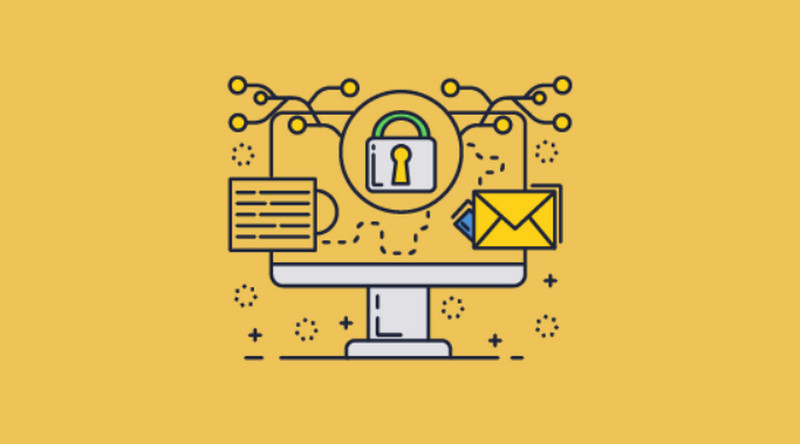
Microsoft software
Sensitive documents
Many organizations utilize DRM technology to safeguard critical business documents and sensitive information, including confidential employee data, business plans, and contracts. DRM facilitates tracking of file views, control over file access, and management of file usage, preventing alterations, duplications, saving, or printing.
Regulation compliance
DRM plays a pivotal role in aiding organizations in compliance with data protection regulations. For instance, it enables healthcare organizations to meet the requirements of the Health Insurance Portability and Accountability Act (HIPAA) and assists all organizations in complying with the California Consumer Privacy Act (CCPA) and the EU’s General Data Protection Regulation (GDPR).
Advantages of what is digital rights management
In addition to shielding copyright holders and content creators from piracy, DRM offers various other significant advantages.
Copyright education
DRM plays a vital role in educating individuals about copyright details related to their owned content. By clearly communicating what users can and cannot do with their digital media, organizations use DRM to enhance awareness and understanding of copyright and intellectual property principles.
Securing ownership
DRM is essential for authors and writers seeking to safeguard their creative work. By leveraging technology, they can maintain ownership of their content and prevent any unauthorized alterations or rebranding by others. This is particularly valuable for scientists looking to protect their discoveries and inventions.
Protecting income
The production process of documentaries, movies, and other videos involves significant financial investment with the expectation of earning a profit from content sales. DRM becomes crucial in preventing unauthorized leaks or sharing, ensuring that content creators can exclusively provide access to paying users, thereby safeguarding their income.
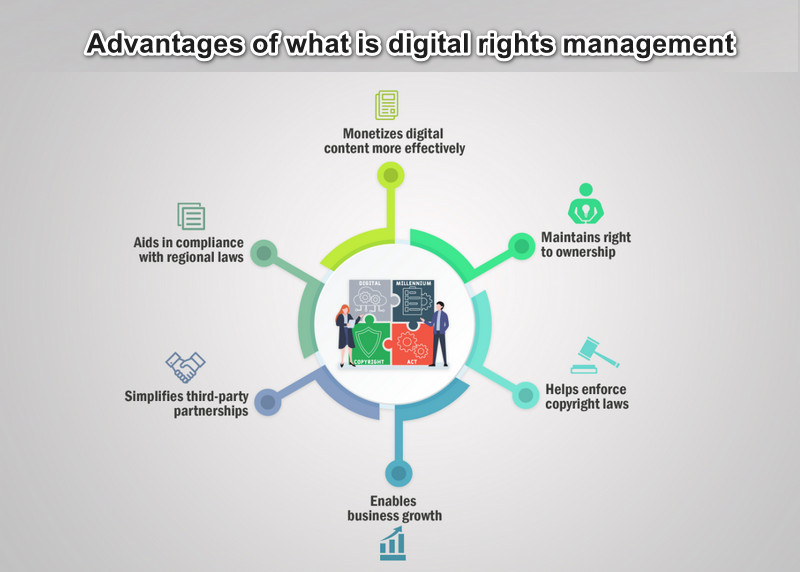
Advantages of what is digital rights management
Ensuring appropriate content access
DRM serves to restrict content access to specific audiences and aligns content with its intended viewership. For instance, content designed for individuals above the age of 18 can be limited to adults who can verify their age.
File privacy
DRM aids organizations in fortifying the security of sensitive files, ensuring their confidentiality. This measure prevents unauthorized users from accessing or reading confidential and sensitive information.
Software for Digital Rights Management (DRM)
DRM technology is available in the form of software or hardware solutions, both serving as options for content creators to thwart intentional piracy and inadvertent unauthorized usage.
Digital asset management platforms empower organizations to regulate access to copyrighted material through various means, such as:
Watermarks
Graphic files applied to assets enable creators or copyright holders to trace unauthorized usage, persisting even when the digital content undergoes copying, manipulation, or transformation into another format.
Metadata
Digital assets incorporate metadata facilitating the capture and monitoring of copyright and licensing information. This is crucial for tracking licensing details of stock audio files, photos, and videos to prevent unauthorized usage.
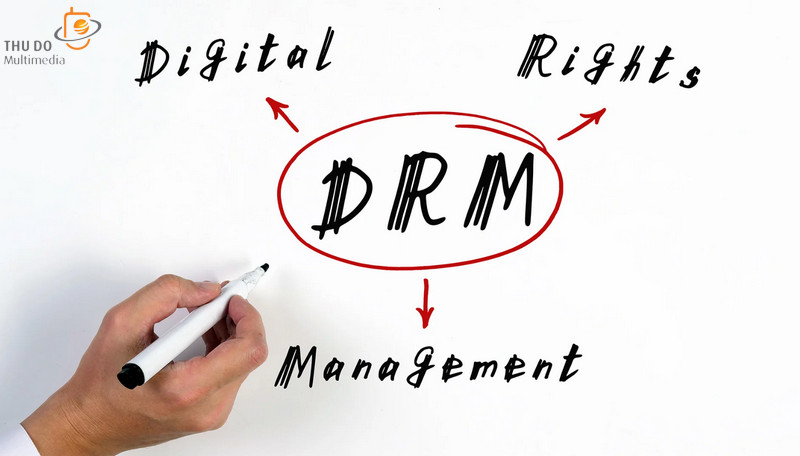
Software for Digital Rights Management (DRM)
Embed codes
Content owners leverage embed codes to govern how and where their media is published online. This proves beneficial when the license of an image changes or expires, allowing for the modification or update of the license wherever the corresponding embed code has been posted online. This approach is also known as “create once, publish everywhere” (COPE), a pivotal aspect of a successful DRM strategy.
License agreements
Organizations can fortify the protection of their content and software by mandating users to read and agree to their end-user license agreement (EULA). An EULA is affirmed the first time a user accesses a website, shares files, or downloads content, serving as a safeguard to prevent unauthorized usage of organizational assets.
Cybersecurity Challenges in the Media and Entertainment Industry
While DRM plays a crucial role in safeguarding digital content, media and entertainment organizations must establish robust security solutions and processes to protect their assets. They encounter common challenges, including:
Intellectual Property Protection
Media and entertainment companies face the critical task of safeguarding content such as music files, movies, videos, as well as sensitive materials like contract negotiations, scripts, and cut scenes. The Sony Pictures hack, revealing employee data and unreleased content, underscored the significant impact leaks can have on a company’s reputation and financial standing. The use of DRM is vital in mitigating these risks and protecting valuable content.
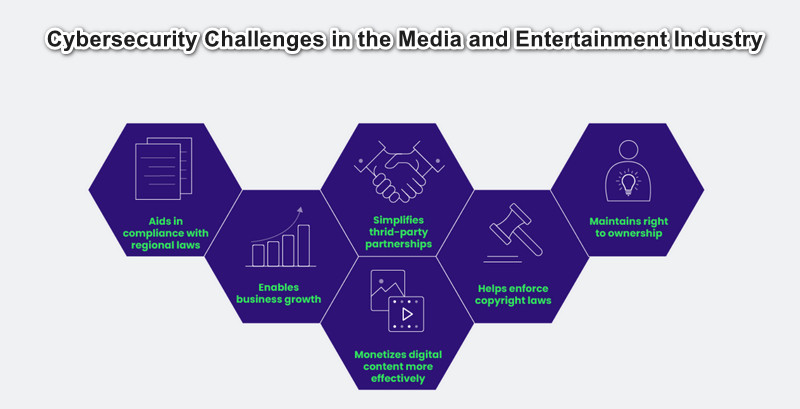
Cybersecurity Challenges in the Media and Entertainment Industry
Network Visibility
The adoption of cutting-edge technology to enhance customer experience in the entertainment and media sector, including cloud, mobile, and Internet-of-Things (IoT) devices, adds complexity to network management. This growth, coupled with the deployment of multiple security products, results in security silos that diminish visibility, increase inefficiency, and elevate the risk of cyber threats.
Protecting Investments
Entertainment and media ventures entail substantial upfront investments before yielding profits. Prioritizing security spending becomes imperative to safeguard these investments and minimize associated risks.
Managing Customer Experience
Given the emphasis on digital innovation for customer experience, organizations witness the rapid ascent of streaming services, online gaming, and virtual reality. These services rely on secure cloud-based solutions and mobile networks, making them susceptible to disruptions in connectivity. Meeting customer demands becomes crucial to preserve reputation and prevent financial losses.
Protecting Customer Data
Major media and entertainment companies, entrusted with the personal and financial data of millions, must adhere to increasingly stringent data and privacy regulations. Safeguarding this data is paramount, necessitating compliance with evolving regulatory landscapes without compromising staff resources dedicated to strategic initiatives.
What are the advantages of Thu Do Multimedia’s Sigma Multi DRM solution?
Multi DRM Help Partners:
- Use the world’s leading comprehen-sive security solution including: PlayReadym Widevine & Fairplay
- Implemented on 100% of all, device terminals
- Provide the highest quality content to end users.
- Reduce CDN cost loss.
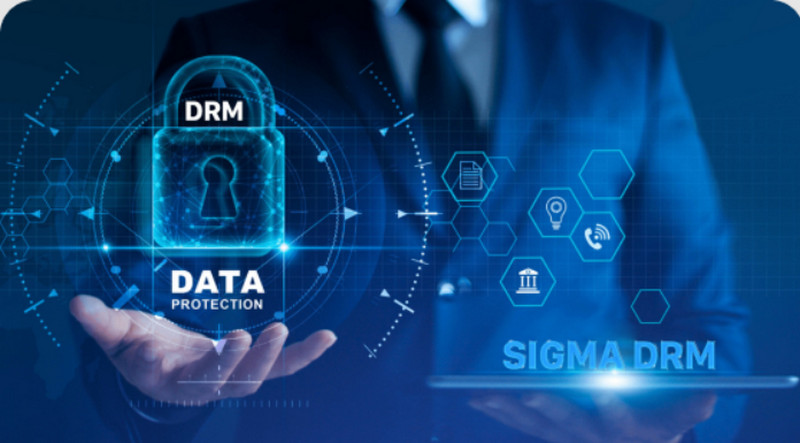
Sigma Multi DRM
Strengths:
- Multi-platform, multi-browser support: IOS/Android/WebaOS/Tizen Chrome/Firefox/Edge/Android TV STB…
- Multi DRM support: Sigma DRM, Playready, Fairplay, Widevide.
- Optimize response speed from DRM System to client
- Caters to millions of concurrent users, scalable to server streaming needs.
- The system is fully developed and controlled by a team of staff in Vietnam at a competitive cost.
- Most outstanding point: 24/7, flexible operating support in Vietnam an inter-nationally.
Hopefully through the above information about solutions to protect what is digital rights management. This part helps readers get more useful information. To learn more about this great solution. Please refer and view at website address: thudomultimedia.com.
Or booking a meeting with our consultant!
>>> See more articles: The DRM market is expected to reach $8.2 billion by 2027

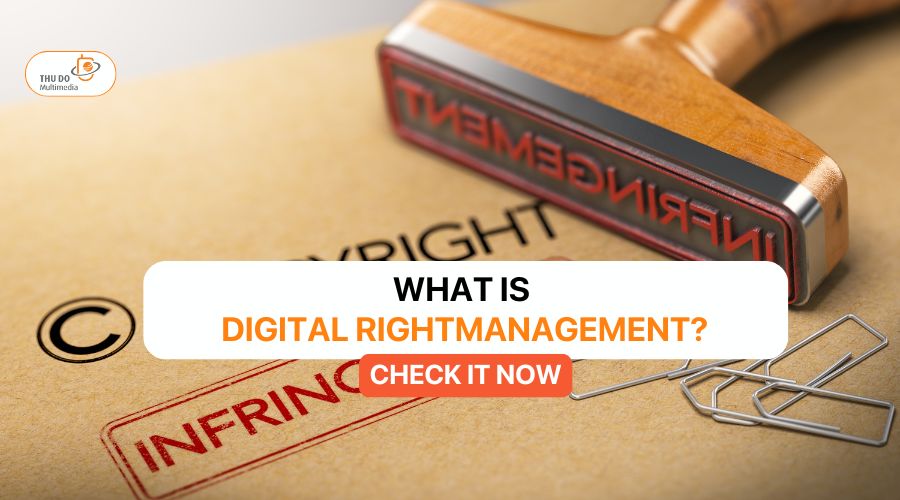
Recent Comments